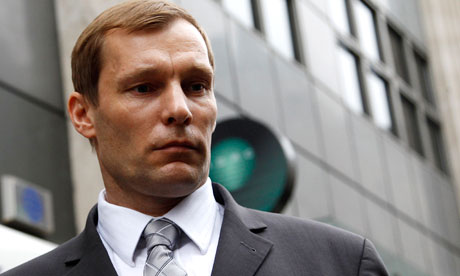Ian Tomlinson inquest hears barrister accuse G20 officer of lying on oath
PC Simon Harwood back-tracks on claim that Ian Tomlinson had been acting 'defiantly' at G20 protests

PC Simon Harwood leaves the inquest into the death of Ian Tomlinson. Photograph: Stefan Wermuth/REUTERS
The police officer who pushed and struck Ian Tomlinson shortly before his death was accused of lying under oath after stating that the newspaper seller had been "almost inviting a physical confrontation" at the G20 protests.
Giving evidence to the Tomlinson inquest for the third and final day, PC Simon Harwood initially told the jury that the father of nine had been defiantly obstructing a police line. Tomlinson, 47, collapsed and died moments after the confrontation near the Bank of England on 1 April 2009.
Harwood initially maintained he had not pushed Tomlinson from behind – despite video footage that showed he did. His insistence that Tomlinson did not have his back turned when he struck him prompted Matthew Ryder QC, for the Tomlinson family, to accuse him of giving "absurd" testimony.
"The problem is that we have video of that day when you were there," Ryder said. "That is rubbish, I suggest to you, PC Harwood, and you know it." The police officer replied: "I was there and I saw what I saw."
The judge presiding over the inquest, Peter Thornton QC, told the police officer he did not have to answer any questions he believed would incriminate himself. However by the end of the day, Harwood had back-tracked. After further questioning from Thornton, he accepted that Tomlinson was walking away from police. He also accepted the newspaper seller was not acting "defiantly" and had his back turned to him when he struck him with a baton and pushed him to the ground.
When Harwood, a member of the Metropolitan police's territorial support group, appeared to give the jury a loose explanation of when he could use his baton, Ryder sought clarification.
"Does your training tell you if someone is not a threat to you or any other person it is acceptable to baton them? Is that your training? "Yes," replied Harwood. He believed he could use his baton when not under threat "in some circumstances".
But Samantha Leek, counsel for the Met, told Harwood she was not aware of "any training" that permitted such behaviour.
Harwood referred to the instructions on use of force he said he received at the Met's public order training centre in Gravesend, Kent. Harwood told the jury he had not expected Tomlinson to fall to the ground as a result of the push, which came immediately after his baton strike.
Ryder asked: "Someone who has his back to you, you push him with that force, from behind and you didn't expect he might fall to the ground?" Harwood replied: "No." The barrister again accused him of lying and asked if the officer had intended to "make an example" of Tomlinson – which Harwood denied. "Because that would be a pretty horrible thing to do, do you agree? Just to make an example of them. Do you agree with that?" "Yes," said the officer.
Questioned by his own barrister, Patrick Gibbs QC, Harwood said he had found it difficult to distinguish in his evidence between his recollections of the day and what he had since seen in video.
"It is for me almost impossible, very, very difficult … to be able to ascertain the differences between what I remember then, on the day, to now," he said.
The inquest continues.

No comments:
Post a Comment